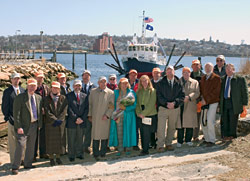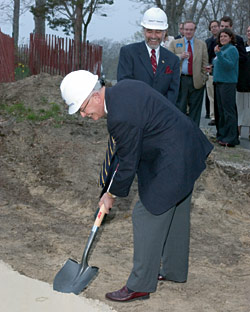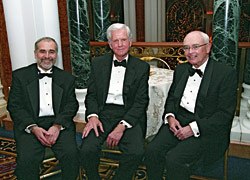 |
 Enlarge image
Enlarge image |
| Tioga
crew, WHOI personnel and members of the Smith family along
with others who supported the new coastal research vessel,
gathered at its launch in March at Gladding-Hearn Shipbuilding
in Somerset, Massachusetts. (Photo by Tom Kleindinst,
WHOI Graphic Services) |
 Enlarge image
Enlarge image |
| Bob Gagosian encourages Jim Moltz, chairman of the Board of Trustees, at the groundbreaking ceremony for the new laboratories being built on the Quissett Campus.
(Photo by Tom Kleindinst, WHOI Graphic Services) |
 Enlarge image
Enlarge image |
| From left, Bob Gagosian, Corporation Chair Tom Wheeler, and Board Chair Jim Moltz were among those attending a formal trustee event in New York on January 6, 2005, the 75th anniversary of the Institutionís incorporation.
(Photo by Elas Ruiz) |
| |
| Related Links |
|
» President and Director's Office
» Campus Improvement (Internal only)
» Hybrid Remotely Operated Vehicle (HROV)
» R/V
Tioga
» Woods Hole Center for Oceans and Human Health
» MIT/WHOI Joint Program
» Capital Campaign
» Ocean Institutes
|
In 2004 we made significant strides in affirming the leadership
position of our Institution and in preparing for difficult
times for federally funded basic research.
We took major steps to enhance our science and education,
both ashore and at sea.
On the Quissett Campus, we broke ground (photo at right) for
much-needed new laboratory space, adding 80,000 square feet
to relieve crowding of our scientists and to accommodate newer
technologies. The project is on time and on budget, with occupancy
scheduled for late 2005. We also provided 10,000 square feet
of space in the village for our Deep Submergence Group.
We signed a $21.6-million cooperative agreement with the National
Science Foundation (NSF) to build a replacement for the venerable
and industrious submersible, Alvin, which was 40
years old in 2004. The replacement sub, which will be the
deepest diving and most technically advanced in the world,
is scheduled for launch in 2008. We also began the design
phase for a hybrid remotely operated vehicle, an innovative
mix of free-swimming and tethered vehicle designs, which will operate to the deepest
ocean depths of 36,000 feet—deeper than Mt. Everest
is high.
Tioga, our new coastal research vessel, completed
its first eight months of operations, logging 75 trips in
support of WHOI science and our at-sea education for undergraduate summer student fellows, and for media outreach.
A joint grant from NSF and the National Institute of Environmental
Health and Sciences funded a new $6.5-million Woods Hole Center
for Oceans and Human Health based at WHOI and operated jointly
with Marine Biological Laboratory and MIT. The center will
coordinate research at the intersection of oceanographic,
biological and environmental health sciences.
An external review committee for our graduate education efforts
reported that “the MIT/WHOI Joint Program remains a
(if not the) top educational program covering all the marine
sciences and engineering”—a ringing endorsement
of the quality of our faculty, staff, and students. In addition,
WHOI rated in the top ten U.S. institutions for postdoctoral
researchers nationwide in a reader survey conducted by the
magazine The Scientist.
A changing attitude toward science
While I’m proud of our accomplishments, we face new
challenges that come from a changing attitude toward science
in the United States.
In 2004, a modest increase in NSF ocean sciences funding did
not keep pace with demand for important research. A rising
percentage of highly rated proposals are being turned down,
which has a demoralizing effect on our scientists.
As we anticipate declining research support from federal agencies,
my focus remains on controlling nonscience expenses while
building sources of revenue. Here, there is some good news.
With the support and efforts of our Board, our fund raising
passed $115 million toward our campaign goal of $200 million.
The campaign enters its public phase in 2005.
Thanks to the talent of our trustee investment committee and
a rebound in Wall Street, by 2004 we recovered the endowment
principle lost in the market downturn since 2001, while distributing
more than $13 million per year since then to support our science.
Our endowment ended 2004 at $291 million, with a 12% annual
average rate of return, outperforming our benchmark. On the
expense side of the balance sheet, our discipline in controlling
administrative costs contributed to positive financial results.
We are also addressing increasing health care and retirement
benefits costs.
A priority for 2005 will be to promote recognition of the
importance of our science. Gone are the days of my youth when
science, while perhaps not widely understood, was at least
widely valued. We can no longer assume the importance of our
work is self-evident to the public and those in government.
Peer-reviewed journal articles are no longer enough. The public
must hear if we are to win its support for science. Congress
must hear. The White House must hear. I believe that if the
science community does not advocate for science, no one else
will.
Advocating for science
Our Ocean Institutes, with their mission to communicate the
importance of our work, are pioneering an approach that will
make our research and its benefit to society broadly understood
and appreciated. This step is essential to win further federal
support for research.
The continuing success of our researchers requires that they
write ever more proposals, eroding the time spent on science.
Today, the average WHOI researcher writes four to six proposals
a year and some write as many as a dozen. Those that are funded,
are often at a level below what they need to achieve their
scientific objectives.
In this environment, private funding increasingly enables
science that likely would not have happened otherwise. Today
about 20% of the Oceanographic’s science is underwritten
by private sources and we are working hard to increase that
figure. Private funding is needed to maintain our ability
to do high-risk, high-reward science that catalyzes our scientific
leadership and pays dividends to society in the long run.
There is some good news in the research arena, despite difficulties
with the NSF budget. The crossroads we stand at today, on
the threshold of the 75th anniversary of our Institution,
presents opportunities we have not encountered in decades.
The recommendations of the U.S. Commission on Ocean Policy
promise to reinvent our country’s policy and funding
framework for ocean science. Congress has renewed consideration
of the U.S. Commission on Ocean Policy recommendations, with
hearings likely to stretch until July 2005.
What would implementation of the Commission recommendations
mean for WHOI?
We are uniquely prepared to take advantage of a renewed emphasis
on oceanography.
First, we have an unmatched scale of sea-going expertise—
ships, tethered and autonomous vehicles, buoys and observatories,
and we are building a new human- occupied submersible.
Second, we have a unique partnership of science and engineering.
We don’t just buy new technology off the shelf and adapt
it. We invent it, design it, build it, test it, and deploy
it.
Third, we have excellent academic programs that cultivate
the inventive minds we will need in the future.
A renewed emphasis on ocean science would mean reinvigorated
demands placed on ocean scientists and engineers. Not only
are we qualified to meet these demands, the Ocean Institutes
have proved their ability to incubate new ideas, and multiply
small private investments into major federal support.
For 75 years, researchers at Woods Hole Oceanographic Institution
have proved their adaptability. During World War II, we did
mainly defense-related work. During the height of the Cold
War, our scientific and technical innovation kept our Navy
a step ahead of the Soviet navy.
Today, we are in another time of change and I am confident
that the world-class creativity and enterprise we nurture
in our extraordinary village will lead us productively into
new waters.

Robert B. Gagosian
President and Director
|

